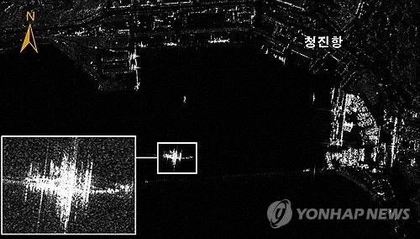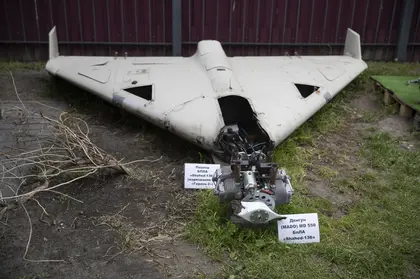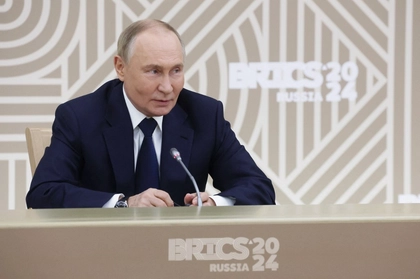The Shahed “kamikaze drone,” known also by its Russian nomenclature as the Geran-2, is more properly classified as a one-way attack unmanned aerial vehicle (OWA UAV).
It has a cropped delta-wing shape, with a central fuselage blending into the wings and stabilizing rudders at the tips. The nose section contains the warhead while the engine sits in the rear of the fuselage, where it drives a two-bladed pusher propeller. Weighing in at about 200 kilograms, it is 3.5 meters long with a 2.5-meter wingspan and flies at over 185 kilometers an hour.
JOIN US ON TELEGRAM
Follow our coverage of the war on the @Kyivpost_official.
Unlike more sophisticated UAVs the Shahed is guided by using inertial pre-set geo-coordinates to the intended target. This simplicity makes them resistant to anti-drone rifles and other electronic warfare systems.
Shahed is Iranian for “Witness,” and the UAV takes its name from its designer, Shahed Aviation Industries. Its first recorded use was in a 2019 Iranian attack by up to 25 Shahed UAVs against oil processing facilities at Abqaiq and Khurais in eastern Saudi Arabia.
The drone is launched from a rack, which holds five drones. After its rocket-assisted near-horizontal launch, it is powered on its mission by a piston engine – which gives the Shahed its distinctive sound in flight, variously referred to as like a “lawn mower” or “moped.” Once it reaches its target, it will nose dive onto it or in the area of it.

Up to 12,000 North Korean Troops Transferred to Russia, Satellite Images Show
Russia has generally launched Shaheds in quick succession to form barrages of up to 40 or more in an attempt to overwhelm Ukraine’s air defenses, inflicting maximum damage on a target.
Since their first appearance, the drones that have been recovered have shown technical modifications – some apparently by design, others forced upon the manufacturer by the necessity of compensating for components blocked by Western sanctions.
Increasingly, Russian-manufactured UAVs are being encountered. The original Iranian production is marked with the letter “M,” a transitional model, assembled in Russia using Iranian parts has the letter “Ы,” with new Russian Shaheds marked with the letter “K.”
Let’s look at the key changes.
The engine
The motor in the original Iranian UAVs was a copy of the German Limbach Flugmotoren L-550 aircraft engine which Teheran calls the MADO MD-550. It is a four-cylinder two-stroke run on gasoline producing 50 bhp. The engines were fitted with Japanese or Irish carburetors and American-made servos, which were later replaced with Chinese versions to control the wings.
The Russian-produced drones use a Chinese copy of the original engine manufactured by the Beijing company MicroPilot UAV Flight Control Systems with a carburetors, servos and even spark plugs being sourced from a number of countries.
A Ukrainian technician examining the UAV said that it was difficult to find anything that had been manufactured in Russia on its engine, adding: “Even the starter button was made by the German company Bosch.”
Navigation
The original Shaheds employed inertial navigation blocks, manufactured in Canada, that relied on commercially available GPS systems for navigation with a limited CEP accuracy of around 10 to 15 meters. The Russian variants use the “Komet” navigation system, which incorporates GLONASS, Russia’s version of GPS for guidance. This is almost the only component of Russian production in these drones.
A recently recovered downed UAV was reported as being fitted with a SIM card linked to a Ukrainian provider and 4G modem. This was seen as probably an improvised Russian attempt to improve real-time guidance by using mobile phone communications towers for reduced reliance on satellite navigation for guidance and to stay one step ahead of possible electronic warfare capability.
As for electronics, both Iran and Russia are almost totally dependent on foreign products obtained through the black market. About 90 percent of chips and electrical parts found inside the drones are of Western manufacture.
Structure
The original Iranian design used a cast fiberglass body lined with a plastic printed honeycomb filler to hold internal components in place.
The newer Russian versions have a composite fuselage filled with a polyurethane-type filler, which is probably used to reduce costs as it seems to offer no operational or other advantage.
Ukrainian air defense teams began to report in early November that they noticed a number of Shaheds were “painted black,” which was assumed to be an attempt to make them less visible to mobile fire teams using cannon and guns to engage the UAV.
It soon became apparent that there was more to this “cosmetic” change: the coating and parts of the Russian-built drones contained carbon fibers which, when combined with the blended delta wing shape of the Shahed, was an attempt, according to Ukrainian Air Force spokesperson Yuriy Ihnat, to make the drones stealthier. The coating would act as both an absorbing material against radar signals and also dissipate some of the heat signature generated by the gasoline engine.
While this modification makes the Shaheds harder to spot on radar, giving defenders less time to engage them, events over the last few weeks suggest that engine noise and the use of searchlights allows them to be successfully engaged by machineguns alone.
Warhead
The standard warhead in the Iranian variant of the UAV is a high-explosive fragmentation charge weighing between 30 and 50 kilograms. A small number have been found with a columnar warhead around which were copper-lined shaped charges.
The Russian version seems to have a slightly smaller explosive charge around which have been packed tungsten ball bearings to act as shrapnel. This warhead weighs 40 kilograms and is believed to be a repurposed warhead from redundant air-launched missiles.
At the beginning of December, a recovered warhead was mis-identified as being a thermobaric warhead as used in the TOS-1, which works by dispersing an aerosol cloud of gas, liquid or powdered explosive with a significantly more energetic result than conventional explosives. This rumor was very quickly dispelled.
With an estimated cost of less than $50,000 and a claimed range of up to 2,000 kilometers, the Shaheds have proven a simple and cheap way for Russia to attack cities far beyond the frontline. They are likely to continue to be used to support the Kremlin’s attacks on Ukraine’s civilian infrastructure in conjunction with or as cost-effective substitutes for Russia’s dwindling stocks of missiles and other long-range weapons.
You can also highlight the text and press Ctrl + Enter






